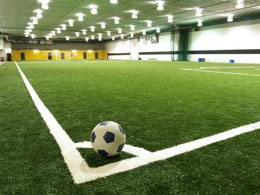Artificial turfs are rapidly gaining popularity, due to their many advantages over natural grass. The following article talks about this synthetic surface, which can be used for sports fields or in residential lawns.

An artificial turf, also known as synthetic grass, is a man-made surface that is manufactured using synthetic materials and resembles natural grass. It is commonly used for sports that are usually played on real grass, but recently it has also found a place in residential lawns and commercial complexes.
Background
David Chaney led the team of researchers who were responsible for creating the artificial turf. In 1965, synthetic grass was installed in the newly built Astrodome, in Houston, Texas. It was at this point, that these turfs gained a lot of prominence. By 1970s, they became widespread and were installed in both indoor and outdoor stadiums, in the United States and Canada. The prominent stadiums that underwent this change were the Riverfront Stadium at Cincinnati, Three Rivers Stadium at Pittsburgh, and Veterans Stadium at Philadelphia.
Present Scenario
The dawn of the 21st century brought with it new synthetic surfaces, which used sand and rubber infill. These 'next generation' turfs brought in the concept of 'Artificial Grass' and are virtually undistinguishable from a distance. Playing on these new turfs is considered to be as safe as real grass and safer during the colder seasons.
Many clubs have already installed the new synthetic grass as a part of all-weather training facilities, while many clubs, who still have the real grass fields, are considering changing to the new turf, because of the various advantages that it offers. Football clubs in Europe too are considering synthetic grass in an effort to reduce maintenance costs and also to reduce the number of matches that are canceled in winters, due to a frozen pitch.
Synthetic grass has also brought about significant changes in the game of hockey. They were introduced on the hockey pitch in the 1970s and now competitions in the western countries are played on synthetic grass. These turfs have increased the speed of the game and have also brought about a change in the shape of the hockey sticks to allow for new techniques, like reverse stick trapping and hitting.
Since the middle of 1990s, artificial turfs have been used in residential and commercial landscaping lawns. The main reason for this being the quality and the variety offered. Secondly, water conservation organizations are being very vocal about the role they will play in saving water.
Advantages
- The main advantage can be seen in areas where the conditions to grow natural grass are very hostile, like areas that are very dry and arid or receive very less sunlight.
- An artificial turf is ideal for holiday homes and elderly home owners, as they are easy to maintain.
- Synthetic grass is also ideal for swimming pool areas and roof gardens.
- It is also an excellent option if cost is a major factor. These turfs last beautifully for ten years.
Disadvantages
- The cuts, abrasions, and burns caused on the synthetic grass are of a greater degree when compared to natural grass. This is because of the friction caused between turf and the human skin. This becomes an issue in many sports, specially football, where the sliding maneuvers are common and clothing does not cover the entire body.
- Players who play regularly on an artificial turf suffer from a medical condition known as the 'Turf Toe'.
- The abrasions have been known to cause a higher incidence of MSRA infections.
- Some varieties require infill of silicon sand or granulated rubber, that is made from recycled car tires. These materials usually carry heavy metals which can leach into the water table.
- Periodical disinfection is required as pathogens are not broken down by any natural process.
- The synthetic grass becomes much hotter under the sun when compared to natural grass.






 An artificial turf, also known as synthetic grass, is a man-made surface that is manufactured using synthetic materials and resembles natural grass. It is commonly used for sports that are usually played on real grass, but recently it has also found a place in residential lawns and commercial complexes.
An artificial turf, also known as synthetic grass, is a man-made surface that is manufactured using synthetic materials and resembles natural grass. It is commonly used for sports that are usually played on real grass, but recently it has also found a place in residential lawns and commercial complexes.